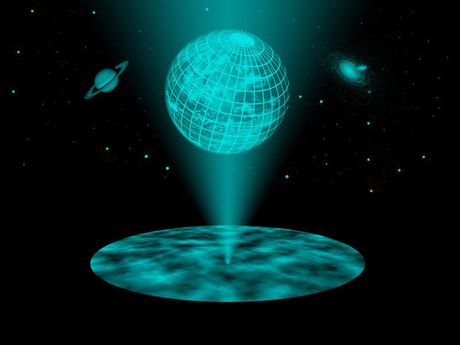Is the universe a hologram?

Describing the universe requires fewer dimensions than we might think. New calculations show that this may not just be a mathematical trick, but a fundamental feature of space itself.
At first glance, there is not the slightest doubt: to us, the universe looks three-dimensional. But one of the most fruitful theories of theoretical physics in the last two decades is challenging this assumption. The ‘holographic principle’ asserts that a mathematical description of the universe actually requires one fewer dimension than it seems. What we perceive as three-dimensional may just be the image of two-dimensional processes on a huge cosmic horizon.
Up until now, this principle has only been studied in exotic spaces with negative curvature. This is interesting from a theoretical point of view, but such spaces are quite different from the space in our own universe. Results obtained by scientists at TU Wien (Vienna) now suggest that the holographic principle even holds in a flat spacetime.
The Holographic Principle
Everybody knows holograms from credit cards or banknotes. They are two-dimensional, but to us they appear three-dimensional. Our universe could behave quite similarly: “In 1997, the physicist Juan Maldacena proposed the idea that there is a correspondence between gravitational theories in curved anti-de sitter spaces on the one hand and quantum field theories in spaces with one fewer dimension on the other,” said Daniel Grumiller (TU Wien).
Gravitational phenomena are described in a theory with three spatial dimensions, the behaviour of quantum particles is calculated in a theory with just two spatial dimensions - and the results of both calculations can be mapped onto each other. Such a correspondence is quite surprising. It is like finding out that equations from an astronomy textbook can also be used to repair a CD player. But this method has proven to be very successful. More than 10,000 scientific papers about Maldacena’s “AdS-CFT-correspondence” have been published to date.
Correspondence even in flat spaces

For theoretical physics, this is extremely important, but it does not seem to have much to do with our own universe. Apparently, we do not live in such an anti-de sitter space. These spaces have quite peculiar properties. They are negatively curved - any object thrown away on a straight line will eventually return. “Our universe, in contrast, is quite flat - and on astronomic distances, it has positive curvature,” said Grumiller.
However, Grumiller has suspected for quite some time that a correspondence principle could also hold true for our real universe. To test this hypothesis, gravitational theories have to be constructed, which do not require exotic anti-de sitter spaces, but live in a flat space. For three years, he and his team at TU Wien have been working on that, in cooperation with the University of Edinburgh, Harvard, IISER Pune, the MIT and the University of Kyoto. Now Grumiller and colleagues from India and Japan have published an article in the journal Physical Review Letters, confirming the validity of the correspondence principle in a flat universe.
Calculated twice, same result
“If quantum gravity in a flat space allows for a holographic description by a standard quantum theory, then there must be physical quantities, which can be calculated in both theories - and the results must agree,” said Grumiller. Especially one key feature of quantum mechanics - quantum entanglement - has to appear in the gravitational theory.
When quantum particles are entangled, they cannot be described individually. They form a single quantum object, even if they are located far apart. There is a measure for the amount of entanglement in a quantum system, called “entropy of entanglement”. Together with Arjun Bagchi, Rudranil Basu and Max Riegler, Daniel Grumiller managed to show that this entropy of entanglement takes the same value in flat quantum gravity and in a low-dimension quantum field theory.
“This calculation affirms our assumption that the holographic principle can also be realised in flat spaces. It is evidence for the validity of this correspondence in our universe,” said Max Riegler (TU Wien). “The fact that we can even talk about quantum information and entropy of entanglement in a theory of gravity is astounding in itself, and would hardly have been imaginable only a few years back. That we are now able to use this as a tool to test the validity of the holographic principle, and that this test works out, is quite remarkable,” said Grumiller.
This, however, does not yet prove that we are indeed living in a hologram - but apparently there is growing evidence for the validity of the correspondence principle in our own universe.
European Space Agency inaugurates deep space antenna in WA
The ESA has expanded its capability to communicate with scientific, exploration and space safety...
Black hole collision supports Hawking's landmark theory
Astrophysicists have witnessed a collision between two black holes that was so loud, they were...
Uncovering differences in wild and domesticated crops
Researchers have revealed insights into the genetic make-up of wild varieties of common crops...



